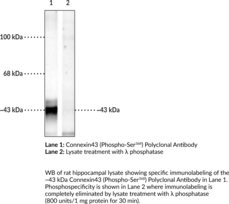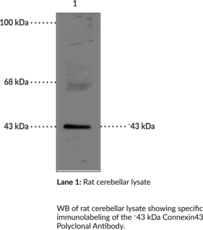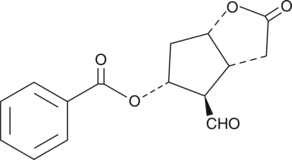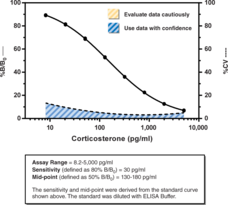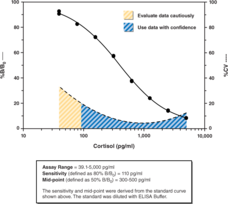Cayman
Showing 16051–16200 of 45550 results
-
Coniferin is a phenylpropanoid glycoside and a lignan precursor that has been found in V. album and has diverse biological activities.{53612,53613,53614} It inhibits ADP-induced platelet aggregation in isolated human platelet-rich plasma when used at concentrations ranging from 0.01 to 1 µM.{53612} Coniferin has antioxidant activity in an oxygen radical absorbance capacity (ORAC) assay.{53613} It induces contractions in isolated rat aortic rings when used at concentrations ranging from 0.001 to 1 mM.{53614} In vivo, coniferin (1 mg/kg) increases blood pressure in spontaneously hypertensive rats.{53615}
Brand:CaymanSKU:30364 - 500 µgAvailable on backorder
Coniferyl alcohol is a monolignol that has been found in pine sap.{53176} It is a precursor in the biosynthesis of lignin and has been used in the synthesis of lignin and a variety of phytochemicals.{53172,53173} Coniferyl alcohol is an inhibitor of S-adenosyl-homocysteine hydrolase (SAAH) in vitro (IC50 = 34 nM).{53174} It increases the promoter activity of Hsp25 and Hsp70 in NCI H460 cells, as well as protein levels of Hsf1, Hsp27, and Hsp70 in L132 human lung fibroblast cells when used at a concentration of 3 µM.{53175} It also prevents cell death of Hsf1+/+, but not Hsf1-/-, mouse embryonic fibroblasts induced by paclitaxel (Item No. 10461), cisplatin (Item No. 13119), or ionizing radiation (IR), and inhibits IR-induced bone marrow damage in mice when administered at a dose of 10 mg/kg.
Brand:CaymanSKU:29470 - 100 mgAvailable on backorder
Coniferyl alcohol is a monolignol that has been found in pine sap.{53176} It is a precursor in the biosynthesis of lignin and has been used in the synthesis of lignin and a variety of phytochemicals.{53172,53173} Coniferyl alcohol is an inhibitor of S-adenosyl-homocysteine hydrolase (SAAH) in vitro (IC50 = 34 nM).{53174} It increases the promoter activity of Hsp25 and Hsp70 in NCI H460 cells, as well as protein levels of Hsf1, Hsp27, and Hsp70 in L132 human lung fibroblast cells when used at a concentration of 3 µM.{53175} It also prevents cell death of Hsf1+/+, but not Hsf1-/-, mouse embryonic fibroblasts induced by paclitaxel (Item No. 10461), cisplatin (Item No. 13119), or ionizing radiation (IR), and inhibits IR-induced bone marrow damage in mice when administered at a dose of 10 mg/kg.
Brand:CaymanSKU:29470 - 250 mgAvailable on backorder
Coniferyl alcohol is a monolignol that has been found in pine sap.{53176} It is a precursor in the biosynthesis of lignin and has been used in the synthesis of lignin and a variety of phytochemicals.{53172,53173} Coniferyl alcohol is an inhibitor of S-adenosyl-homocysteine hydrolase (SAAH) in vitro (IC50 = 34 nM).{53174} It increases the promoter activity of Hsp25 and Hsp70 in NCI H460 cells, as well as protein levels of Hsf1, Hsp27, and Hsp70 in L132 human lung fibroblast cells when used at a concentration of 3 µM.{53175} It also prevents cell death of Hsf1+/+, but not Hsf1-/-, mouse embryonic fibroblasts induced by paclitaxel (Item No. 10461), cisplatin (Item No. 13119), or ionizing radiation (IR), and inhibits IR-induced bone marrow damage in mice when administered at a dose of 10 mg/kg.
Brand:CaymanSKU:29470 - 500 mgAvailable on backorder
Coniferyl ferulate is a monolignol conjugate that has been found in A. sinensis and has diverse biological activities, including antibacterial, antioxidant, enzyme inhibitory, and neuroprotective properties.{48827,48828,48829,48830} It is active against the Gram-positive bacteria B. subtilis and S. aureus.{48828} Coniferyl ferulate scavenges 2,2-diphenyl-1-picrylhydrazyl (DPPH; Item No. 14805) radicals (EC50 = 3.6 µg/ml) and inhibits glutathione S-transferase (GST; IC50 = 0.3 µM for the human placental enzyme) in cell-free assays.{48829,48830} Coniferyl ferulate (10 and 50 µg/ml) reduces cytotoxicity induced by amyloid-β (1-40) (Aβ40) in PC12 cells.{48829}
Brand:CaymanSKU:29620 - 1 mgAvailable on backorder
Coniferyl ferulate is a monolignol conjugate that has been found in A. sinensis and has diverse biological activities, including antibacterial, antioxidant, enzyme inhibitory, and neuroprotective properties.{48827,48828,48829,48830} It is active against the Gram-positive bacteria B. subtilis and S. aureus.{48828} Coniferyl ferulate scavenges 2,2-diphenyl-1-picrylhydrazyl (DPPH; Item No. 14805) radicals (EC50 = 3.6 µg/ml) and inhibits glutathione S-transferase (GST; IC50 = 0.3 µM for the human placental enzyme) in cell-free assays.{48829,48830} Coniferyl ferulate (10 and 50 µg/ml) reduces cytotoxicity induced by amyloid-β (1-40) (Aβ40) in PC12 cells.{48829}
Brand:CaymanSKU:29620 - 10 mgAvailable on backorder
Coniferyl ferulate is a monolignol conjugate that has been found in A. sinensis and has diverse biological activities, including antibacterial, antioxidant, enzyme inhibitory, and neuroprotective properties.{48827,48828,48829,48830} It is active against the Gram-positive bacteria B. subtilis and S. aureus.{48828} Coniferyl ferulate scavenges 2,2-diphenyl-1-picrylhydrazyl (DPPH; Item No. 14805) radicals (EC50 = 3.6 µg/ml) and inhibits glutathione S-transferase (GST; IC50 = 0.3 µM for the human placental enzyme) in cell-free assays.{48829,48830} Coniferyl ferulate (10 and 50 µg/ml) reduces cytotoxicity induced by amyloid-β (1-40) (Aβ40) in PC12 cells.{48829}
Brand:CaymanSKU:29620 - 25 mgAvailable on backorder
Coniferyl ferulate is a monolignol conjugate that has been found in A. sinensis and has diverse biological activities, including antibacterial, antioxidant, enzyme inhibitory, and neuroprotective properties.{48827,48828,48829,48830} It is active against the Gram-positive bacteria B. subtilis and S. aureus.{48828} Coniferyl ferulate scavenges 2,2-diphenyl-1-picrylhydrazyl (DPPH; Item No. 14805) radicals (EC50 = 3.6 µg/ml) and inhibits glutathione S-transferase (GST; IC50 = 0.3 µM for the human placental enzyme) in cell-free assays.{48829,48830} Coniferyl ferulate (10 and 50 µg/ml) reduces cytotoxicity induced by amyloid-β (1-40) (Aβ40) in PC12 cells.{48829}
Brand:CaymanSKU:29620 - 5 mgAvailable on backorder
Conivaptan is an antagonist of the arginine vasopressin (AVP) receptors V1A and V2 (Kis = 0.48 and 3.04 nM for rat liver V1A and kidney V2, respectively).{38430} It also competitively inhibits oxytocin binding to rat uterine oxytocin receptors (Ki = 44 nM) but has no effect on AVP binding to anterior pituitary V1B receptors at concentrations up to 100 μM in a radioligand binding assay. Conivaptan suppresses AVP-induced increases in intracellular calcium in vascular smooth muscle cells (VSMCs) in vitro and the pressor response in pithed rats. Conivaptan (0.01-0.3 mg/kg, i.v.) increases urine output and decreases urine osmolality in dehydrated conscious rats in a dose-dependent manner. It also reduces brain edema and blood-brain barrier disruption in a mouse experimental stroke model.{38431}
Brand:CaymanSKU:23728 - 10 mgAvailable on backorder
Conivaptan is an antagonist of the arginine vasopressin (AVP) receptors V1A and V2 (Kis = 0.48 and 3.04 nM for rat liver V1A and kidney V2, respectively).{38430} It also competitively inhibits oxytocin binding to rat uterine oxytocin receptors (Ki = 44 nM) but has no effect on AVP binding to anterior pituitary V1B receptors at concentrations up to 100 μM in a radioligand binding assay. Conivaptan suppresses AVP-induced increases in intracellular calcium in vascular smooth muscle cells (VSMCs) in vitro and the pressor response in pithed rats. Conivaptan (0.01-0.3 mg/kg, i.v.) increases urine output and decreases urine osmolality in dehydrated conscious rats in a dose-dependent manner. It also reduces brain edema and blood-brain barrier disruption in a mouse experimental stroke model.{38431}
Brand:CaymanSKU:23728 - 25 mgAvailable on backorder
Conivaptan is an antagonist of the arginine vasopressin (AVP) receptors V1A and V2 (Kis = 0.48 and 3.04 nM for rat liver V1A and kidney V2, respectively).{38430} It also competitively inhibits oxytocin binding to rat uterine oxytocin receptors (Ki = 44 nM) but has no effect on AVP binding to anterior pituitary V1B receptors at concentrations up to 100 μM in a radioligand binding assay. Conivaptan suppresses AVP-induced increases in intracellular calcium in vascular smooth muscle cells (VSMCs) in vitro and the pressor response in pithed rats. Conivaptan (0.01-0.3 mg/kg, i.v.) increases urine output and decreases urine osmolality in dehydrated conscious rats in a dose-dependent manner. It also reduces brain edema and blood-brain barrier disruption in a mouse experimental stroke model.{38431}
Brand:CaymanSKU:23728 - 5 mgAvailable on backorder
Conivaptan is an antagonist of the arginine vasopressin (AVP) receptors V1A and V2 (Kis = 0.48 and 3.04 nM for rat liver V1A and kidney V2, respectively).{38430} It also competitively inhibits oxytocin binding to rat uterine oxytocin receptors (Ki = 44 nM) but has no effect on AVP binding to anterior pituitary V1B receptors at concentrations up to 100 μM in a radioligand binding assay. Conivaptan suppresses AVP-induced increases in intracellular calcium in vascular smooth muscle cells (VSMCs) in vitro and the pressor response in pithed rats. Conivaptan (0.01-0.3 mg/kg, i.v.) increases urine output and decreases urine osmolality in dehydrated conscious rats in a dose-dependent manner. It also reduces brain edema and blood-brain barrier disruption in a mouse experimental stroke model.{38431}
Brand:CaymanSKU:23728 - 50 mgAvailable on backorder
Conivaptan-d4 is intended for use as an internal standard for the quantification of conivaptan (Item No. 23728) by GC- or LC-MS. Conivaptan is an antagonist of the arginine vasopressin (AVP) receptors V1A and V2 (Kis = 0.48 and 3.04 nM for rat liver V1A and kidney V2, respectively).{38430} It also competitively inhibits oxytocin binding to rat uterine oxytocin receptors (Ki = 44 nM) but has no effect on AVP binding to anterior pituitary V1B receptors at concentrations up to 100 μM in a radioligand binding assay. Conivaptan suppresses AVP-induced increases in intracellular calcium in vascular smooth muscle cells (VSMCs) in vitro and the pressor response in pithed rats. Conivaptan (0.01-0.3 mg/kg, i.v.) increases urine output and decreases urine osmolality in dehydrated conscious rats in a dose-dependent manner. It also reduces brain edema and blood-brain barrier disruption in a mouse experimental stroke model.{38431}
Brand:CaymanSKU:26455 - 1 mgAvailable on backorder
Conivaptan-d4 is intended for use as an internal standard for the quantification of conivaptan (Item No. 23728) by GC- or LC-MS. Conivaptan is an antagonist of the arginine vasopressin (AVP) receptors V1A and V2 (Kis = 0.48 and 3.04 nM for rat liver V1A and kidney V2, respectively).{38430} It also competitively inhibits oxytocin binding to rat uterine oxytocin receptors (Ki = 44 nM) but has no effect on AVP binding to anterior pituitary V1B receptors at concentrations up to 100 μM in a radioligand binding assay. Conivaptan suppresses AVP-induced increases in intracellular calcium in vascular smooth muscle cells (VSMCs) in vitro and the pressor response in pithed rats. Conivaptan (0.01-0.3 mg/kg, i.v.) increases urine output and decreases urine osmolality in dehydrated conscious rats in a dose-dependent manner. It also reduces brain edema and blood-brain barrier disruption in a mouse experimental stroke model.{38431}
Brand:CaymanSKU:26455 - 500 µgAvailable on backorder
Immunogen: Phosphopeptide corresponding to amino acid residues surrounding phospho-Ser368 of rat connexin43 • Host: Rabbit • Species Reactivity: (+) Mouse, rat • Application: WB • MW = ~43 kDa
Brand:CaymanSKU:29258- 100 µlConnexin43 (Cx43) is a membrane protein and member of the connexin family that is encoded by GJA1 in humans.{55146,55147} It is widely expressed across various tissues, including heart, brain, and retina, and exhibits plasma membrane localization. Cx43 is a monomeric component of connexons, homo- or heterohexamers that form hydrophilic pores and facilitate the exchange of ions and secondary messengers between the cytoplasm of connected cells at gap junctions. It is essential to cardiomyocyte function and cardiac development, osteoblast and osteocyte survival, and spermatogenesis.{55146} Cx43 is also expressed in various tumor cells, including liver, prostate, and breast, and exhibits tumor-specific pro- or anti-metastatic effects.{55146,55148} The C-terminus of Cx43 is subject to various post-translational modifications, including phosphorylation. Phosphorylation of Cx43 at position 386 (phospho-Ser368) is mediated by protein kinase C (PKC) and p38 MAPK.{55150,55151} PKC-mediated phosphorylation of Cx43 is increased in a mouse model of acute respiratory distress syndrome (ARDS).{55150} IL-1β increases p38 MAPK-mediated phosphorylation of Cx43 at Ser368 in a perfused rat heart model of myocarditis.{55151} Cayman’s Connexin43 (Phospho-Ser368) Polyclonal Antibody can be used for Western blot (WB) applications. The antibody recognizes connexin43 (phospho-Ser368) at approximately 43 kDa from mouse and rat samples.
Brand:CaymanSKU:29258 - 100 µlAvailable on backorder
Immunogen: Phosphopeptide corresponding to amino acid residues surrounding phospho-Ser368 of rat connexin43 • Host: Rabbit • Species Reactivity: (+) Mouse, rat • Application: WB • MW = ~43 kDa
Brand:CaymanSKU:29258- 100 µlAvailable on backorder
Immunogen: Peptide corresponding to amino acid residues from the C-terminal region of rat connexin43 • Host: Rabbit • Species Reactivity: (+) Rat • Applications: WB • MW = ~43 kDa
Brand:CaymanSKU:29257- 100 µlConnexin43 (Cx43) is a membrane protein and member of the connexin family that is encoded by GJA1 in humans.{55146,55147} It is widely expressed across various tissues, including the heart, brain, and retina, and exhibits plasma membrane localization. Cx43 is a monomeric component of connexons, homo- or heterohexamers that form hydrophilic pores and facilitate the exchange of ions and secondary messengers between the cytoplasm of connected cells at gap junctions. It is essential to cardiomyocyte function and cardiac development, osteoblast and osteocyte survival, and spermatogenesis.{55146} Cx43 is also expressed in various tumor cells, including in the liver, prostate, and breast, and exhibits tumor-specific pro- or anti-metastatic effects.{55146,55148} Inhibition of Gja1 with antisense oligonucleotides promotes wound healing in murine skin, skeletal muscle, cardiac tissue, and vascular endothelium, however, global heterozygous knockdown of Gja1 increases infarct size in a mouse model of ischemia and reperfusion injury.{55146,55147} Levels of Cx43 are decreased in postmortem retinal samples from patients with diabetes compared with control individuals.{55149} Cayman’s Connexin43 Polyclonal Antibody can be used for Western blot (WB) applications. The antibody recognizes connexin43 at approximately 43 kDa from rat samples.
Brand:CaymanSKU:29257 - 100 µlAvailable on backorder
Immunogen: Peptide corresponding to amino acid residues from the C-terminal region of rat connexin43 • Host: Rabbit • Species Reactivity: (+) Rat • Applications: WB • MW = ~43 kDa
Brand:CaymanSKU:29257- 100 µlAvailable on backorder
Peroxiredoxins are a widely conserved family of enzymes that function in antioxidant defense and act in redox signaling pathways. Increased expression of human peroxiredoxin is associated with cancer, cardiovascular dysfunction, and neurodegeneration. Conoidin A inactivates peroxiredoxins by covalently binding to the catalytic cysteine on the enzyme.{25622,25624} It has been shown to inhibit peroxiredoxin II (IC50 = 23 µM) in the parasite T. gondii and peroxiredoxin I in the hookworm A. ceylanicum.{25622,25623,25624} At 5 µM, conoidin A can also inhibit the glucose oxidase-mediated hyperoxidation of mammalian peroxiredoxin I and II, but not peroxiredoxin III.{25622}
Brand:CaymanSKU:-Peroxiredoxins are a widely conserved family of enzymes that function in antioxidant defense and act in redox signaling pathways. Increased expression of human peroxiredoxin is associated with cancer, cardiovascular dysfunction, and neurodegeneration. Conoidin A inactivates peroxiredoxins by covalently binding to the catalytic cysteine on the enzyme.{25622,25624} It has been shown to inhibit peroxiredoxin II (IC50 = 23 µM) in the parasite T. gondii and peroxiredoxin I in the hookworm A. ceylanicum.{25622,25623,25624} At 5 µM, conoidin A can also inhibit the glucose oxidase-mediated hyperoxidation of mammalian peroxiredoxin I and II, but not peroxiredoxin III.{25622}
Brand:CaymanSKU:-Peroxiredoxins are a widely conserved family of enzymes that function in antioxidant defense and act in redox signaling pathways. Increased expression of human peroxiredoxin is associated with cancer, cardiovascular dysfunction, and neurodegeneration. Conoidin A inactivates peroxiredoxins by covalently binding to the catalytic cysteine on the enzyme.{25622,25624} It has been shown to inhibit peroxiredoxin II (IC50 = 23 µM) in the parasite T. gondii and peroxiredoxin I in the hookworm A. ceylanicum.{25622,25623,25624} At 5 µM, conoidin A can also inhibit the glucose oxidase-mediated hyperoxidation of mammalian peroxiredoxin I and II, but not peroxiredoxin III.{25622}
Brand:CaymanSKU:-Peroxiredoxins are a widely conserved family of enzymes that function in antioxidant defense and act in redox signaling pathways. Increased expression of human peroxiredoxin is associated with cancer, cardiovascular dysfunction, and neurodegeneration. Conoidin A inactivates peroxiredoxins by covalently binding to the catalytic cysteine on the enzyme.{25622,25624} It has been shown to inhibit peroxiredoxin II (IC50 = 23 µM) in the parasite T. gondii and peroxiredoxin I in the hookworm A. ceylanicum.{25622,25623,25624} At 5 µM, conoidin A can also inhibit the glucose oxidase-mediated hyperoxidation of mammalian peroxiredoxin I and II, but not peroxiredoxin III.{25622}
Brand:CaymanSKU:-Convulxin is a toxin that was first isolated from rattlesnake venom. It activates the collagen receptor glycoprotein VI (GPVI) on platelets and initiates blood clotting.{30506,30504} Convulxin is used to study signaling through GPVI and to characterize platelet function.{30503,30502,30505}
Brand:CaymanSKU:-Available on backorder
Coomassie blue R-250 is a dye that is commonly used in laboratories to stain or quantify proteins. It is a sensitive stain for protein detection in polyacrylamide gels, typically giving blue bands on a clear background with a sensitivity of 50-100 ng/band. It may be combined with other stains, such as silver stain, to distinguish different types of proteins.{23012} Coomassie blue R-250 displays metachromasia by appearing pink-red, rather than blue, when binding certain proteins, such as collagen and histone H1.{23011}
Brand:CaymanSKU:-Coomassie blue R-250 is a dye that is commonly used in laboratories to stain or quantify proteins. It is a sensitive stain for protein detection in polyacrylamide gels, typically giving blue bands on a clear background with a sensitivity of 50-100 ng/band. It may be combined with other stains, such as silver stain, to distinguish different types of proteins.{23012} Coomassie blue R-250 displays metachromasia by appearing pink-red, rather than blue, when binding certain proteins, such as collagen and histone H1.{23011}
Brand:CaymanSKU:-Coomassie blue R-250 is a dye that is commonly used in laboratories to stain or quantify proteins. It is a sensitive stain for protein detection in polyacrylamide gels, typically giving blue bands on a clear background with a sensitivity of 50-100 ng/band. It may be combined with other stains, such as silver stain, to distinguish different types of proteins.{23012} Coomassie blue R-250 displays metachromasia by appearing pink-red, rather than blue, when binding certain proteins, such as collagen and histone H1.{23011}
Brand:CaymanSKU:-Coomassie blue R-250 is a dye that is commonly used in laboratories to stain or quantify proteins. It is a sensitive stain for protein detection in polyacrylamide gels, typically giving blue bands on a clear background with a sensitivity of 50-100 ng/band. It may be combined with other stains, such as silver stain, to distinguish different types of proteins.{23012} Coomassie blue R-250 displays metachromasia by appearing pink-red, rather than blue, when binding certain proteins, such as collagen and histone H1.{23011}
Brand:CaymanSKU:-Copanlisib is an inhibitor of class I phosphoinositide 3-kinase (PI3K) isoforms (IC50s = 0.5, 3.7, 6.4, and 0.7 nM for α, β, γ, and δ, respectively).{32958} It is weakly active or inactive against numerous other kinases. Copanlisib is effective in vivo when administered intravenously, inhibiting PI3K signaling and inducing tumor regression via apoptosis in xenograft tumors in mice.{32958,32959}
Brand:CaymanSKU:20354 -Available on backorder
Copanlisib is an inhibitor of class I phosphoinositide 3-kinase (PI3K) isoforms (IC50s = 0.5, 3.7, 6.4, and 0.7 nM for α, β, γ, and δ, respectively).{32958} It is weakly active or inactive against numerous other kinases. Copanlisib is effective in vivo when administered intravenously, inhibiting PI3K signaling and inducing tumor regression via apoptosis in xenograft tumors in mice.{32958,32959}
Brand:CaymanSKU:20354 -Available on backorder
Copanlisib is an inhibitor of class I phosphoinositide 3-kinase (PI3K) isoforms (IC50s = 0.5, 3.7, 6.4, and 0.7 nM for α, β, γ, and δ, respectively).{32958} It is weakly active or inactive against numerous other kinases. Copanlisib is effective in vivo when administered intravenously, inhibiting PI3K signaling and inducing tumor regression via apoptosis in xenograft tumors in mice.{32958,32959}
Brand:CaymanSKU:20354 -Available on backorder
Coprostanol is a cholesterol derivative formed in mammals by intestinal microorganisms and is the odorous compound in feces.{48399} It is formed via conversion of cholesterol to cholestenone (Item No. 25713) then coprostanone intermediates or by direct reduction of the 5,6 double bond. Coprostanol is commonly used as a marker of sewage contamination in soil and watersheds.{48400,48401}
Brand:CaymanSKU:26764 - 10 mgAvailable on backorder
Coprostanol is a cholesterol derivative formed in mammals by intestinal microorganisms and is the odorous compound in feces.{48399} It is formed via conversion of cholesterol to cholestenone (Item No. 25713) then coprostanone intermediates or by direct reduction of the 5,6 double bond. Coprostanol is commonly used as a marker of sewage contamination in soil and watersheds.{48400,48401}
Brand:CaymanSKU:26764 - 100 mgAvailable on backorder
Coprostanol is a cholesterol derivative formed in mammals by intestinal microorganisms and is the odorous compound in feces.{48399} It is formed via conversion of cholesterol to cholestenone (Item No. 25713) then coprostanone intermediates or by direct reduction of the 5,6 double bond. Coprostanol is commonly used as a marker of sewage contamination in soil and watersheds.{48400,48401}
Brand:CaymanSKU:26764 - 5 mgAvailable on backorder
Coprostanol is a cholesterol derivative formed in mammals by intestinal microorganisms and is the odorous compound in feces.{48399} It is formed via conversion of cholesterol to cholestenone (Item No. 25713) then coprostanone intermediates or by direct reduction of the 5,6 double bond. Coprostanol is commonly used as a marker of sewage contamination in soil and watersheds.{48400,48401}
Brand:CaymanSKU:26764 - 50 mgAvailable on backorder
Coptisine is an isoquinoline alkaloid that has been found in Coptis chinensis and has diverse biological activities, including antioxidant, enzyme inhibitory, antiproliferative, and anti‑hypercholesterolemic properties.{47685,52041,47686,50112,50111} It inhibits the production of reactive oxygen species (ROS) in isolated kidney mitochondria in a 2,7-dichlorodihydrofluorescein diacetate (DCFH-DA; Item No. 85155) assay (IC50 = 48.93 μM).{47685} Coptisine inhibits acetylcholinesterase (AChE) and butyrylcholinesterase (BChE) but not β-secretase 1 (BACE1) in cell-free enzyme assays (IC50s = 0.8, 5.81, and >100 μM, respectively). It also inhibits indoleamine 2,3-dioxygenase (IDO) in vitro (IC50 = 6.3 μM), as well as organic cation transporter 1 (OCT1), OCT2, and OCT3 in MDCK cells (IC50s = 0.931, 2.27, and 2.27 μM, respectively, for the human transporters).{52041,47686} It inhibits proliferation of A549, H460, and H2170 human lung cancer cells with IC50 values of 18.09, 29.5, and 21.6 μM, respectively.{50112} Coptisine (70.05 mg/kg) decreases total serum cholesterol, triglyceride, and LDL-cholesterol levels and increases serum HDL-cholesterol levels in Syrian golden hamsters fed a high-fat and high-cholesterol diet.{50111}
Brand:CaymanSKU:28424 - 10 mgAvailable on backorder
Coptisine is an isoquinoline alkaloid that has been found in Coptis chinensis and has diverse biological activities, including antioxidant, enzyme inhibitory, antiproliferative, and anti‑hypercholesterolemic properties.{47685,52041,47686,50112,50111} It inhibits the production of reactive oxygen species (ROS) in isolated kidney mitochondria in a 2,7-dichlorodihydrofluorescein diacetate (DCFH-DA; Item No. 85155) assay (IC50 = 48.93 μM).{47685} Coptisine inhibits acetylcholinesterase (AChE) and butyrylcholinesterase (BChE) but not β-secretase 1 (BACE1) in cell-free enzyme assays (IC50s = 0.8, 5.81, and >100 μM, respectively). It also inhibits indoleamine 2,3-dioxygenase (IDO) in vitro (IC50 = 6.3 μM), as well as organic cation transporter 1 (OCT1), OCT2, and OCT3 in MDCK cells (IC50s = 0.931, 2.27, and 2.27 μM, respectively, for the human transporters).{52041,47686} It inhibits proliferation of A549, H460, and H2170 human lung cancer cells with IC50 values of 18.09, 29.5, and 21.6 μM, respectively.{50112} Coptisine (70.05 mg/kg) decreases total serum cholesterol, triglyceride, and LDL-cholesterol levels and increases serum HDL-cholesterol levels in Syrian golden hamsters fed a high-fat and high-cholesterol diet.{50111}
Brand:CaymanSKU:28424 - 100 mgAvailable on backorder
Coptisine is an isoquinoline alkaloid that has been found in Coptis chinensis and has diverse biological activities, including antioxidant, enzyme inhibitory, antiproliferative, and anti‑hypercholesterolemic properties.{47685,52041,47686,50112,50111} It inhibits the production of reactive oxygen species (ROS) in isolated kidney mitochondria in a 2,7-dichlorodihydrofluorescein diacetate (DCFH-DA; Item No. 85155) assay (IC50 = 48.93 μM).{47685} Coptisine inhibits acetylcholinesterase (AChE) and butyrylcholinesterase (BChE) but not β-secretase 1 (BACE1) in cell-free enzyme assays (IC50s = 0.8, 5.81, and >100 μM, respectively). It also inhibits indoleamine 2,3-dioxygenase (IDO) in vitro (IC50 = 6.3 μM), as well as organic cation transporter 1 (OCT1), OCT2, and OCT3 in MDCK cells (IC50s = 0.931, 2.27, and 2.27 μM, respectively, for the human transporters).{52041,47686} It inhibits proliferation of A549, H460, and H2170 human lung cancer cells with IC50 values of 18.09, 29.5, and 21.6 μM, respectively.{50112} Coptisine (70.05 mg/kg) decreases total serum cholesterol, triglyceride, and LDL-cholesterol levels and increases serum HDL-cholesterol levels in Syrian golden hamsters fed a high-fat and high-cholesterol diet.{50111}
Brand:CaymanSKU:28424 - 25 mgAvailable on backorder
Coptisine is an isoquinoline alkaloid that has been found in Coptis chinensis and has diverse biological activities, including antioxidant, enzyme inhibitory, antiproliferative, and anti‑hypercholesterolemic properties.{47685,52041,47686,50112,50111} It inhibits the production of reactive oxygen species (ROS) in isolated kidney mitochondria in a 2,7-dichlorodihydrofluorescein diacetate (DCFH-DA; Item No. 85155) assay (IC50 = 48.93 μM).{47685} Coptisine inhibits acetylcholinesterase (AChE) and butyrylcholinesterase (BChE) but not β-secretase 1 (BACE1) in cell-free enzyme assays (IC50s = 0.8, 5.81, and >100 μM, respectively). It also inhibits indoleamine 2,3-dioxygenase (IDO) in vitro (IC50 = 6.3 μM), as well as organic cation transporter 1 (OCT1), OCT2, and OCT3 in MDCK cells (IC50s = 0.931, 2.27, and 2.27 μM, respectively, for the human transporters).{52041,47686} It inhibits proliferation of A549, H460, and H2170 human lung cancer cells with IC50 values of 18.09, 29.5, and 21.6 μM, respectively.{50112} Coptisine (70.05 mg/kg) decreases total serum cholesterol, triglyceride, and LDL-cholesterol levels and increases serum HDL-cholesterol levels in Syrian golden hamsters fed a high-fat and high-cholesterol diet.{50111}
Brand:CaymanSKU:28424 - 50 mgAvailable on backorder
Cordycepin is a nucleoside analog found in C. sinensis that acts as a polyadenylation inhibitor when converted to cordycepin triphosphate, which inhibits ATP-dependent DNA and RNA synthesis.{22954} Cordycepin has a broad spectrum of biological activities, including anti-proliferative, pro-apoptotic, and anti-inflammatory effects.{22954,22953,22955} Cordycepin has been shown to reduce poly(A) tail length in mRNA at 10 μM and to activate AMPK kinase, leading to a reduction in mTOR signaling at 200 μM.{22954}
Brand:CaymanSKU:-Cordycepin is a nucleoside analog found in C. sinensis that acts as a polyadenylation inhibitor when converted to cordycepin triphosphate, which inhibits ATP-dependent DNA and RNA synthesis.{22954} Cordycepin has a broad spectrum of biological activities, including anti-proliferative, pro-apoptotic, and anti-inflammatory effects.{22954,22953,22955} Cordycepin has been shown to reduce poly(A) tail length in mRNA at 10 μM and to activate AMPK kinase, leading to a reduction in mTOR signaling at 200 μM.{22954}
Brand:CaymanSKU:-Cordycepin is a nucleoside analog found in C. sinensis that acts as a polyadenylation inhibitor when converted to cordycepin triphosphate, which inhibits ATP-dependent DNA and RNA synthesis.{22954} Cordycepin has a broad spectrum of biological activities, including anti-proliferative, pro-apoptotic, and anti-inflammatory effects.{22954,22953,22955} Cordycepin has been shown to reduce poly(A) tail length in mRNA at 10 μM and to activate AMPK kinase, leading to a reduction in mTOR signaling at 200 μM.{22954}
Brand:CaymanSKU:-Cordycepin is a nucleoside analog found in C. sinensis that acts as a polyadenylation inhibitor when converted to cordycepin triphosphate, which inhibits ATP-dependent DNA and RNA synthesis.{22954} Cordycepin has a broad spectrum of biological activities, including anti-proliferative, pro-apoptotic, and anti-inflammatory effects.{22954,22953,22955} Cordycepin has been shown to reduce poly(A) tail length in mRNA at 10 μM and to activate AMPK kinase, leading to a reduction in mTOR signaling at 200 μM.{22954}
Brand:CaymanSKU:-Corey lactone aldehyde benzoate is a versatile, chiral intermediate used in the preparation of prostaglandins and prostaglandin analogs.
Brand:CaymanSKU:70030 - 1 gAvailable on backorder
Corey lactone aldehyde benzoate is a versatile, chiral intermediate used in the preparation of prostaglandins and prostaglandin analogs.
Brand:CaymanSKU:70030 - 5 gAvailable on backorder
Corey lactone aldehyde benzoate is a versatile, chiral intermediate used in the preparation of prostaglandins and prostaglandin analogs.
Brand:CaymanSKU:70030 - 500 mgAvailable on backorder
Corilagin is a polyphenol and hydrolyzable tannin that can be isolated from a variety of plants.{25980,25976} It inhibits squalene epoxidase (IC50 = 4.0 µM), a key enzyme in cholesterol synthesis.{25980} Corilagin also has various anti-inflammatory and anti-cancer effects.{25976,25979,25978,25977}
Brand:CaymanSKU:11832 - 1 mgAvailable on backorder
Corilagin is a polyphenol and hydrolyzable tannin that can be isolated from a variety of plants.{25980,25976} It inhibits squalene epoxidase (IC50 = 4.0 µM), a key enzyme in cholesterol synthesis.{25980} Corilagin also has various anti-inflammatory and anti-cancer effects.{25976,25979,25978,25977}
Brand:CaymanSKU:11832 - 10 mgAvailable on backorder
Corilagin is a polyphenol and hydrolyzable tannin that can be isolated from a variety of plants.{25980,25976} It inhibits squalene epoxidase (IC50 = 4.0 µM), a key enzyme in cholesterol synthesis.{25980} Corilagin also has various anti-inflammatory and anti-cancer effects.{25976,25979,25978,25977}
Brand:CaymanSKU:11832 - 25 mgAvailable on backorder
Corilagin is a polyphenol and hydrolyzable tannin that can be isolated from a variety of plants.{25980,25976} It inhibits squalene epoxidase (IC50 = 4.0 µM), a key enzyme in cholesterol synthesis.{25980} Corilagin also has various anti-inflammatory and anti-cancer effects.{25976,25979,25978,25977}
Brand:CaymanSKU:11832 - 5 mgAvailable on backorder
Corosolic acid is a triterpenoid that has been found in L. speciosa leaves and has diverse biological activities, including anticancer, anti-inflammatory, antidiabetic, antihypertensive, antihyperlipidemic, and antioxidant properties.{42869,42870,42871,42872} It is cytotoxic to HepG2, A549, SNU-C4, HeLa S3, and K562 cells (EC50s = 4.8, 5, 0.4, 1, and 4.3 μg/ml, respectively).{42869} Corosolic acid inhibits ear edema in mice induced by phorbol 12-myristate 13-acetate (TPA; Item No. 10008014) with an ID50 value of 0.09 mg/ear.{42870} It reduces blood glucose levels in an insulin tolerance test in a KKAy mouse model of type 2 diabetes when administered at doses of 2 and 10 mg/kg.{42871} Corosolic acid (0.072% in the diet) reduces systolic blood pressure and serum levels of free fatty acids, the oxidative stress markers thiobarbituric acid-reactive substances (TBARS) and 8-hydroxy-2’-deoxyguanosine (8-OHdG), and the myeloperoxidase markers 3-nitrotyrosine and 3-chlorotyrosine in an SHR/NDmcr-cp (cp/cp) rat model of metabolic syndrome.{42872}
Brand:CaymanSKU:27887 - 10 mgAvailable on backorder
Corosolic acid is a triterpenoid that has been found in L. speciosa leaves and has diverse biological activities, including anticancer, anti-inflammatory, antidiabetic, antihypertensive, antihyperlipidemic, and antioxidant properties.{42869,42870,42871,42872} It is cytotoxic to HepG2, A549, SNU-C4, HeLa S3, and K562 cells (EC50s = 4.8, 5, 0.4, 1, and 4.3 μg/ml, respectively).{42869} Corosolic acid inhibits ear edema in mice induced by phorbol 12-myristate 13-acetate (TPA; Item No. 10008014) with an ID50 value of 0.09 mg/ear.{42870} It reduces blood glucose levels in an insulin tolerance test in a KKAy mouse model of type 2 diabetes when administered at doses of 2 and 10 mg/kg.{42871} Corosolic acid (0.072% in the diet) reduces systolic blood pressure and serum levels of free fatty acids, the oxidative stress markers thiobarbituric acid-reactive substances (TBARS) and 8-hydroxy-2’-deoxyguanosine (8-OHdG), and the myeloperoxidase markers 3-nitrotyrosine and 3-chlorotyrosine in an SHR/NDmcr-cp (cp/cp) rat model of metabolic syndrome.{42872}
Brand:CaymanSKU:27887 - 25 mgAvailable on backorder
Corosolic acid is a triterpenoid that has been found in L. speciosa leaves and has diverse biological activities, including anticancer, anti-inflammatory, antidiabetic, antihypertensive, antihyperlipidemic, and antioxidant properties.{42869,42870,42871,42872} It is cytotoxic to HepG2, A549, SNU-C4, HeLa S3, and K562 cells (EC50s = 4.8, 5, 0.4, 1, and 4.3 μg/ml, respectively).{42869} Corosolic acid inhibits ear edema in mice induced by phorbol 12-myristate 13-acetate (TPA; Item No. 10008014) with an ID50 value of 0.09 mg/ear.{42870} It reduces blood glucose levels in an insulin tolerance test in a KKAy mouse model of type 2 diabetes when administered at doses of 2 and 10 mg/kg.{42871} Corosolic acid (0.072% in the diet) reduces systolic blood pressure and serum levels of free fatty acids, the oxidative stress markers thiobarbituric acid-reactive substances (TBARS) and 8-hydroxy-2’-deoxyguanosine (8-OHdG), and the myeloperoxidase markers 3-nitrotyrosine and 3-chlorotyrosine in an SHR/NDmcr-cp (cp/cp) rat model of metabolic syndrome.{42872}
Brand:CaymanSKU:27887 - 5 mgAvailable on backorder
Corosolic acid is a triterpenoid that has been found in L. speciosa leaves and has diverse biological activities, including anticancer, anti-inflammatory, antidiabetic, antihypertensive, antihyperlipidemic, and antioxidant properties.{42869,42870,42871,42872} It is cytotoxic to HepG2, A549, SNU-C4, HeLa S3, and K562 cells (EC50s = 4.8, 5, 0.4, 1, and 4.3 μg/ml, respectively).{42869} Corosolic acid inhibits ear edema in mice induced by phorbol 12-myristate 13-acetate (TPA; Item No. 10008014) with an ID50 value of 0.09 mg/ear.{42870} It reduces blood glucose levels in an insulin tolerance test in a KKAy mouse model of type 2 diabetes when administered at doses of 2 and 10 mg/kg.{42871} Corosolic acid (0.072% in the diet) reduces systolic blood pressure and serum levels of free fatty acids, the oxidative stress markers thiobarbituric acid-reactive substances (TBARS) and 8-hydroxy-2’-deoxyguanosine (8-OHdG), and the myeloperoxidase markers 3-nitrotyrosine and 3-chlorotyrosine in an SHR/NDmcr-cp (cp/cp) rat model of metabolic syndrome.{42872}
Brand:CaymanSKU:27887 - 50 mgAvailable on backorder
Cortexolone 17α-propionate is a peripherally selective androgen receptor antagonist.{45540} Cortexolone 17α-propionate binds to the androgen receptor (AR) and inhibits AR-regulated transcription in a reporter assay.{45539} It also inhibits androgen-regulated lipid synthesis in primary human sebocytes. Cortexolone 17α-propionate inhibits inflammatory cytokine production from primary human sebocytes and scalp dermal papilla cells.{45539,45538} It inhibits testosterone propionate-induced flank organ enlargement in Syrian golden hamsters by 84% when administered topically at a dose of 400 μg/animal.
Brand:CaymanSKU:28392 - 10 mgAvailable on backorder
Cortexolone 17α-propionate is a peripherally selective androgen receptor antagonist.{45540} Cortexolone 17α-propionate binds to the androgen receptor (AR) and inhibits AR-regulated transcription in a reporter assay.{45539} It also inhibits androgen-regulated lipid synthesis in primary human sebocytes. Cortexolone 17α-propionate inhibits inflammatory cytokine production from primary human sebocytes and scalp dermal papilla cells.{45539,45538} It inhibits testosterone propionate-induced flank organ enlargement in Syrian golden hamsters by 84% when administered topically at a dose of 400 μg/animal.
Brand:CaymanSKU:28392 - 100 mgAvailable on backorder
Cortexolone 17α-propionate is a peripherally selective androgen receptor antagonist.{45540} Cortexolone 17α-propionate binds to the androgen receptor (AR) and inhibits AR-regulated transcription in a reporter assay.{45539} It also inhibits androgen-regulated lipid synthesis in primary human sebocytes. Cortexolone 17α-propionate inhibits inflammatory cytokine production from primary human sebocytes and scalp dermal papilla cells.{45539,45538} It inhibits testosterone propionate-induced flank organ enlargement in Syrian golden hamsters by 84% when administered topically at a dose of 400 μg/animal.
Brand:CaymanSKU:28392 - 25 mgAvailable on backorder
Cortexolone 17α-propionate is a peripherally selective androgen receptor antagonist.{45540} Cortexolone 17α-propionate binds to the androgen receptor (AR) and inhibits AR-regulated transcription in a reporter assay.{45539} It also inhibits androgen-regulated lipid synthesis in primary human sebocytes. Cortexolone 17α-propionate inhibits inflammatory cytokine production from primary human sebocytes and scalp dermal papilla cells.{45539,45538} It inhibits testosterone propionate-induced flank organ enlargement in Syrian golden hamsters by 84% when administered topically at a dose of 400 μg/animal.
Brand:CaymanSKU:28392 - 5 mgAvailable on backorder
Corticosterone is a steroid hormone produced in the cortex of the adrenal glands that binds to both glucocorticoid and mineralocorticoid receptors.{26042} It is produced in response to ACTH (corticotropic hormone) and is the precursor to aldosterone synthesis.{19056} Since the production of glucocorticoids is increased by stress, it is often used as a biomarker of stress.{11468} Plasma corticosterone levels have a circadian variation and corticosterone may be important in the regulation of the sleep-wake cycle.{11469,11480}
Brand:CaymanSKU:-Corticosterone is a steroid hormone produced in the cortex of the adrenal glands that binds to both glucocorticoid and mineralocorticoid receptors.{26042} It is produced in response to ACTH (corticotropic hormone) and is the precursor to aldosterone synthesis.{19056} Since the production of glucocorticoids is increased by stress, it is often used as a biomarker of stress.{11468} Plasma corticosterone levels have a circadian variation and corticosterone may be important in the regulation of the sleep-wake cycle.{11469,11480}
Brand:CaymanSKU:-Corticosterone is a steroid hormone produced in the cortex of the adrenal glands that binds to both glucocorticoid and mineralocorticoid receptors.{26042} It is produced in response to ACTH (corticotropic hormone) and is the precursor to aldosterone synthesis.{19056} Since the production of glucocorticoids is increased by stress, it is often used as a biomarker of stress.{11468} Plasma corticosterone levels have a circadian variation and corticosterone may be important in the regulation of the sleep-wake cycle.{11469,11480}
Brand:CaymanSKU:-Corticosterone is a steroid hormone produced in the cortex of the adrenal glands that binds to both glucocorticoid and mineralocorticoid receptors.{26042} It is produced in response to ACTH (corticotropic hormone) and is the precursor to aldosterone synthesis.{19056} Since the production of glucocorticoids is increased by stress, it is often used as a biomarker of stress.{11468} Plasma corticosterone levels have a circadian variation and corticosterone may be important in the regulation of the sleep-wake cycle.{11469,11480}
Brand:CaymanSKU:-Brand:CaymanSKU:401322 - 100 dtnAvailable on backorder
Brand:CaymanSKU:401322 - 500 dtnAvailable on backorder
Corticosterone is a glucocorticoid produced by the adrenal cortex in response to ACTH (corticotropic hormone) and is the precursor to aldosterone. The production of glucorcorticoids is increased by stress; therefore, corticosterone can be used as a biomarker of stress.{11468} Biologists often measure corticosterone in fecal material of the species they are studying.{11468,11469} This non-invasive sample collection procedure has the advantage of not itself causing stress and thereby increasing corticosterone levels, a common problem when samples for measurement of corticosterone are collected by more invasive means.{11468} Plasma corticosterone levels have a circadian variation and corticosterone may be important in the regulation of the sleep-wake cycle.{11469,11480} Cayman’s Corticosterone ELISA Kit is a competitive assay that can be used for quantification of corticosterone in serum and rodent feces.
Brand:CaymanSKU:501320 - 480 solid wellsAvailable on backorder
Corticosterone is a glucocorticoid produced by the adrenal cortex in response to ACTH (corticotropic hormone) and is the precursor to aldosterone. The production of glucorcorticoids is increased by stress; therefore, corticosterone can be used as a biomarker of stress.{11468} Biologists often measure corticosterone in fecal material of the species they are studying.{11468,11469} This non-invasive sample collection procedure has the advantage of not itself causing stress and thereby increasing corticosterone levels, a common problem when samples for measurement of corticosterone are collected by more invasive means.{11468} Plasma corticosterone levels have a circadian variation and corticosterone may be important in the regulation of the sleep-wake cycle.{11469,11480} Cayman’s Corticosterone ELISA Kit is a competitive assay that can be used for quantification of corticosterone in serum and rodent feces.
Brand:CaymanSKU:501320 - 480 strip wellsAvailable on backorder
Corticosterone is a glucocorticoid produced by the adrenal cortex in response to ACTH (corticotropic hormone) and is the precursor to aldosterone. The production of glucorcorticoids is increased by stress; therefore, corticosterone can be used as a biomarker of stress.{11468} Biologists often measure corticosterone in fecal material of the species they are studying.{11468,11469} This non-invasive sample collection procedure has the advantage of not itself causing stress and thereby increasing corticosterone levels, a common problem when samples for measurement of corticosterone are collected by more invasive means.{11468} Plasma corticosterone levels have a circadian variation and corticosterone may be important in the regulation of the sleep-wake cycle.{11469,11480} Cayman’s Corticosterone ELISA Kit is a competitive assay that can be used for quantification of corticosterone in serum and rodent feces.
Brand:CaymanSKU:501320 - 96 solid wellsAvailable on backorder
Corticosterone is a glucocorticoid produced by the adrenal cortex in response to ACTH (corticotropic hormone) and is the precursor to aldosterone. The production of glucorcorticoids is increased by stress; therefore, corticosterone can be used as a biomarker of stress.{11468} Biologists often measure corticosterone in fecal material of the species they are studying.{11468,11469} This non-invasive sample collection procedure has the advantage of not itself causing stress and thereby increasing corticosterone levels, a common problem when samples for measurement of corticosterone are collected by more invasive means.{11468} Plasma corticosterone levels have a circadian variation and corticosterone may be important in the regulation of the sleep-wake cycle.{11469,11480} Cayman’s Corticosterone ELISA Kit is a competitive assay that can be used for quantification of corticosterone in serum and rodent feces.
Brand:CaymanSKU:501320 - 96 strip wellsAvailable on backorder
Brand:CaymanSKU:400657 - 1 eaAvailable on backorder
Corticosterone-d8 is intended for use as an internal standard for the quantification of corticosterone (Item No. 16063) by GC- or LC-MS. Corticosterone is a steroid hormone produced in the cortex of the adrenal glands that binds to both glucocorticoid and mineralocorticoid receptors.{26042} It is produced in response to adrenocorticotropic hormone (ACTH) and is the precursor to aldosterone synthesis.{19056} Since the production of glucocorticoids is increased by stress, it is often used as a biomarker of stress.{11468} Plasma corticosterone levels have a circadian variation and corticosterone may be important in the regulation of the sleep-wake cycle.{11469,11480}
Brand:CaymanSKU:28524 - 5 mgAvailable on backorder
Cortisol is a glucocorticoid produced by the adrenal cortex in response to adrenocorticotropic hormone (ACTH). It is secreted with a circadian periodicity, and peaks just prior to waking in the morning. Cortisol is often elevated in major depressive disorder, certain forms of hypertension, stress, AIDS, and in the visceral fat of obese individuals. Cortisol can be measured in many matrices including blood, urine, and saliva. In serum, approximately 90-95% of cortisol is bound to proteins. Urinary cortisol is not bound to proteins, but its levels are dependent on glomerular and tubular function. In saliva, approximately 67% of cortisol is unbound. There is generally good correlation between cortisol measurements in saliva and serum. Cayman’s Cortisol ELISA Kit is a competitive assay that can be used for quantification of cortisol in urine, plasma, and other sample matrices. The assay has a range from 6.6-4,000 pg/ml and a sensitivity (80% B/B0) of approximately 35 pg/ml.NOTE: Due to an approximate 15% cross-reactivity with dexamethasone, this kit may not be suitable for use with samples that contain high concentrations of dexamethasone, such as those collected during a dexamethasone suppression test.
Brand:CaymanSKU:500360 - 480 solid wellsAvailable on backorder
Cortisol is a glucocorticoid produced by the adrenal cortex in response to adrenocorticotropic hormone (ACTH). It is secreted with a circadian periodicity, and peaks just prior to waking in the morning. Cortisol is often elevated in major depressive disorder, certain forms of hypertension, stress, AIDS, and in the visceral fat of obese individuals. Cortisol can be measured in many matrices including blood, urine, and saliva. In serum, approximately 90-95% of cortisol is bound to proteins. Urinary cortisol is not bound to proteins, but its levels are dependent on glomerular and tubular function. In saliva, approximately 67% of cortisol is unbound. There is generally good correlation between cortisol measurements in saliva and serum. Cayman’s Cortisol ELISA Kit is a competitive assay that can be used for quantification of cortisol in urine, plasma, and other sample matrices. The assay has a range from 6.6-4,000 pg/ml and a sensitivity (80% B/B0) of approximately 35 pg/ml.NOTE: Due to an approximate 15% cross-reactivity with dexamethasone, this kit may not be suitable for use with samples that contain high concentrations of dexamethasone, such as those collected during a dexamethasone suppression test.
Brand:CaymanSKU:500360 - 480 strip wellsAvailable on backorder
Cortisol is a glucocorticoid produced by the adrenal cortex in response to adrenocorticotropic hormone (ACTH). It is secreted with a circadian periodicity, and peaks just prior to waking in the morning. Cortisol is often elevated in major depressive disorder, certain forms of hypertension, stress, AIDS, and in the visceral fat of obese individuals. Cortisol can be measured in many matrices including blood, urine, and saliva. In serum, approximately 90-95% of cortisol is bound to proteins. Urinary cortisol is not bound to proteins, but its levels are dependent on glomerular and tubular function. In saliva, approximately 67% of cortisol is unbound. There is generally good correlation between cortisol measurements in saliva and serum. Cayman’s Cortisol ELISA Kit is a competitive assay that can be used for quantification of cortisol in urine, plasma, and other sample matrices. The assay has a range from 6.6-4,000 pg/ml and a sensitivity (80% B/B0) of approximately 35 pg/ml.NOTE: Due to an approximate 15% cross-reactivity with dexamethasone, this kit may not be suitable for use with samples that contain high concentrations of dexamethasone, such as those collected during a dexamethasone suppression test.
Brand:CaymanSKU:500360 - 96 solid wellsAvailable on backorder
Cortisol is a glucocorticoid produced by the adrenal cortex in response to adrenocorticotropic hormone (ACTH). It is secreted with a circadian periodicity, and peaks just prior to waking in the morning. Cortisol is often elevated in major depressive disorder, certain forms of hypertension, stress, AIDS, and in the visceral fat of obese individuals. Cortisol can be measured in many matrices including blood, urine, and saliva. In serum, approximately 90-95% of cortisol is bound to proteins. Urinary cortisol is not bound to proteins, but its levels are dependent on glomerular and tubular function. In saliva, approximately 67% of cortisol is unbound. There is generally good correlation between cortisol measurements in saliva and serum. Cayman’s Cortisol ELISA Kit is a competitive assay that can be used for quantification of cortisol in urine, plasma, and other sample matrices. The assay has a range from 6.6-4,000 pg/ml and a sensitivity (80% B/B0) of approximately 35 pg/ml.NOTE: Due to an approximate 15% cross-reactivity with dexamethasone, this kit may not be suitable for use with samples that contain high concentrations of dexamethasone, such as those collected during a dexamethasone suppression test.
Brand:CaymanSKU:500360 - 96 strip wellsAvailable on backorder
Brand:CaymanSKU:400364 - 1 eaAvailable on backorder
Cayman’s Cortisol Express ELISA is a competitive assay that permits the rapid measurement of cortisol from biological samples, requiring only a two hour incubation and one hour development times. This ELISA offers the convenience of a fast assay while maintaining sensitivity.NOTE: Due to an approximate 15% cross-reactivity with dexamethasone, this kit may not be suitable for use with samples that contain high concentrations of dexamethasone, such as those collected during a dexamethasone suppression test.
Brand:CaymanSKU:500370 - 480 solid wellsAvailable on backorder
Cayman’s Cortisol Express ELISA is a competitive assay that permits the rapid measurement of cortisol from biological samples, requiring only a two hour incubation and one hour development times. This ELISA offers the convenience of a fast assay while maintaining sensitivity.NOTE: Due to an approximate 15% cross-reactivity with dexamethasone, this kit may not be suitable for use with samples that contain high concentrations of dexamethasone, such as those collected during a dexamethasone suppression test.
Brand:CaymanSKU:500370 - 480 strip wellsAvailable on backorder
Cayman’s Cortisol Express ELISA is a competitive assay that permits the rapid measurement of cortisol from biological samples, requiring only a two hour incubation and one hour development times. This ELISA offers the convenience of a fast assay while maintaining sensitivity.NOTE: Due to an approximate 15% cross-reactivity with dexamethasone, this kit may not be suitable for use with samples that contain high concentrations of dexamethasone, such as those collected during a dexamethasone suppression test.
Brand:CaymanSKU:500370 - 96 solid wellsAvailable on backorder
Cayman’s Cortisol Express ELISA is a competitive assay that permits the rapid measurement of cortisol from biological samples, requiring only a two hour incubation and one hour development times. This ELISA offers the convenience of a fast assay while maintaining sensitivity.NOTE: Due to an approximate 15% cross-reactivity with dexamethasone, this kit may not be suitable for use with samples that contain high concentrations of dexamethasone, such as those collected during a dexamethasone suppression test.
Brand:CaymanSKU:500370 - 96 strip wellsAvailable on backorder
Brand:CaymanSKU:400374 - 1 eaAvailable on backorder





